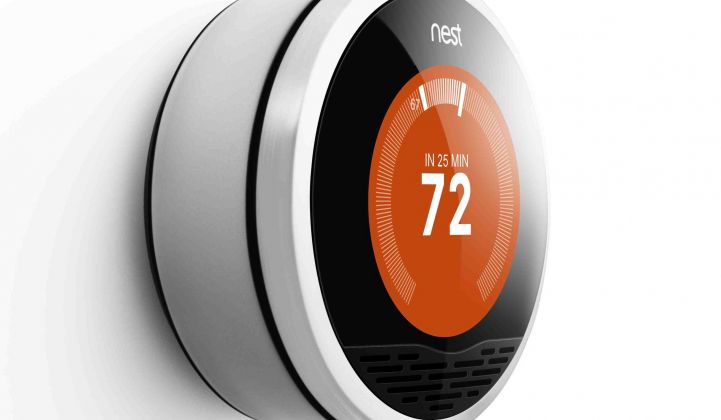Greentech Media broke the Nest thermostat story in June, much to the chagrin of the once-stealthy company and its lawyers.
Nest builds thermostats -- beautiful, smart and expensive thermostats. Nest CEO Tony Fadell, an Apple alum, thought something better could be done in the thermostat space and users could have a better experience than that provided by the "Honeywell Round."
Nest officially unveiled its product in a tightly controlled manner, as befits its Apple roots, in October. Both the technical and popular press were filled with breathless wonder about what would emerge from an Apple-fied home thermostat.
We took a slightly contrarian view.
Thermostats need to turn on in the morning and turn off at night and when we go away.
They do not command the emotional connection we have with smart phones or tablets. It will be an enormous challenge for Nest to recreate the excitement of an entertainment product in a utilitarian device like a thermostat.
And the public will not tolerate beta releases of a thermostat as they would for a piece of software.
The Nest unit boasts temperature sensors, humidity sensors, and ambient light sensors. Power comes over existing thermostat wires, which makes it compatible with 85 percent to 90 percent of American homes. The unit sells for $249, and users install it themselves or pay an additional $119 for a service that provides for installation. By means of comparison, conventional, non-beautiful programmable thermostats typically sell for $40 to $100. This tear-down shows the build quality of the device.
WiredPrairie has done an eight-part installation and performance review on the Nest thermostat. And although the reviewers like the aesthetics and packaging, there is a bit to be desired in terms of performance, quality control, and customer service at the thermostat startup. Nothing that can't be ironed out over time, but a less than auspicious start for the "sold-out" device.
The reviewer and commenters are having trouble with the "learning" feature, which they attest is confused by varying habitation schedules and "can't even adapt to simple schedules." The site says, "I strongly recommend you not buy a Nest thermostat. It’s an undone, expensive piece of hardware, that while shiny and new, isn’t ready for the duties it claims to have mastered."
Kate Brinks, Nest's Director of Corporate Communications, had this response in an email exchange:
Schedule Learning was designed for people who don't want to program their thermostat, which is about 90 percent of U.S. users. Schedule Learning is not for everyone, such as people who may not have regular schedules or those who like to program their thermostats. If a customer doesn't like this feature, he can simply pause it and program his preferred schedule more easily than any other thermostat on the market. This can be done on the device itself or using the Web or Nest mobile apps.
With regard to Auto-Away, the customer states that he’s come home to a cold home on nights when his schedule specified a warmer setpoint. The point of Auto-Away is to save energy from the existing schedule when people aren’t home. If the customer would like to come home to a pre-heated house, he can use our Web or mobile app to turn up the temperature before returning home. If this is too inconvenient, he can turn off Auto-Away in the settings menu. This isn’t the same as turning off “learning.” Of course, if the WiredPrairie customer is unhappy with the product, he can return it for a full refund. We stand behind our product 100 percent.
Our shipping product is not a beta release, nor is it a static device. Similar to other connected devices (e.g., TiVo), Nest has the ability to deliver over-the-air software updates to introduce new features and improvements. This is one of the advantages of Nest: it gets better over time without requiring new hardware. We appreciate all customer input because it helps us make continual product improvements.
Some of the glitches outlined by these early adopters might be fixed with firmware updates.
Here are positive reviews from an early adopter and another user.
One colleague, a home HVAC expert, referred to the Nest product as the Bang & Olufsen of thermostats -- meaning it was heavy on eye-catching design but expensive and less than distinguished in performance.
Controlling a home's HVAC system amidst erratic schedules and idiosyncratic temperature ranges is a challenging task and a somewhat imprecise science.
It's not that the Nest team isn't made up of a group of great, enthusiastic people. Matt Rogers, the founder and VP of Engineering, managed the iPod software team. Tony Fadell, the CEO and founder of Nest, is referred to as the father of the iPhone. Erik Charlton was in charge of pointing devices at Logitech. They are world-class, badass industrial designers with Google, Apple, Microsoft, Tellme, and General Magic pedigrees.
And these engineers have overcome enormous challenges in the past.
In May 2010, the team raised somewhere in the vicinity of $50 million to $80 million from Kleiner Perkins, Google Ventures, Shasta Ventures, Al Gore's Generation Investment Management, Lightspeed Venture Partners, and Intertrust.
_547_492_80.jpg)



